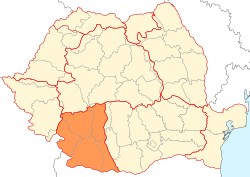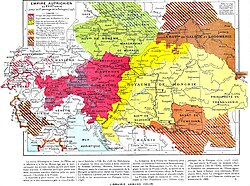Oltenia
Oltenia | |
|---|---|
 | |
| Nickname: "Lesser Wallachia" | |
 Oltenia within the Regions of Romania | |
| Coordinates:44°30′N23°30′E/ 44.500°N 23.500°E | |
| Country | |
| Largest city | Craiova |
| Area | |
| • Total | 24,095 km2(9,303 sq mi) |
| Demonym | Oltenian |
| Time zone | UTC+2(EET) |
| • Summer (DST) | UTC+3(EEST) |
Oltenia(Romanian pronunciation:[olˈteni.a],also calledLesserWallachiain antiquated versions, with the alternativeLatinnamesWallachia Minor,Wallachia Alutana,Wallachia Caesareabetween 1718 and 1739) is a historical province and geographical region ofRomaniain western Wallachia. It is situated between theDanube,theSouthern Carpathiansand theOlt river.
History[edit]
| History ofRomania |
|---|
 |
|
|
Ancient times[edit]

Initially inhabited byDacians,Oltenia was incorporated in theRoman Empire(106, at the end of theDacian Wars;seeRoman Dacia). In 129, duringHadrian's rule, it formedDacia Inferior,one of the two divisions of the province (together withDacia Superior,in today'sTransylvania);Marcus Aurelius' administrative reform made Oltenia one of the three new divisions (tres Daciae) asDacia Malvensis,its capital and chief city being namedRomula.It was colonized withveteransof theRoman legions.The Romans withdrew their administration south of the Danube at the end of the 3rd century and Oltenia was ruled by thefoederatiGermanicGoths.In the late 4th century Oltenia came under the rule of theTaifalsbefore invasion by theHuns.
Middle Ages[edit]

From 681, with some interruptions, it was part of theBulgarian Empire(seeBulgarian lands across the Danube).[citation needed]

In 1233, theKingdom of Hungaryformed theBanate of Severinin the western part of the region that would persist until the 1526Battle of Mohács.
Around 1247, a polity emerged in Oltenia under the rule ofLitovoi.The rise of the medieval state ofWallachiafollowed in the 14th century, and thevoivode(Prince of Wallachia) was represented in Oltenia by aban- "theGreat Ban of Craiova"(with seat inCraiovaafter it was moved fromStrehaia). This came to be considered the greatest office in Wallachian hierarchy, and one that was held most by members of theCraioveștifamily, from the late 15th century to about 1550. The title would continue to exist up until 1831.
During the 15th century, Wallachia had to accept theOttomansuzeraintyand to pay an annualtributeto keep its autonomy as a vassal. From the Craiovești family, many bans cooperated with the Turks. However, many rulers, including the Oltenian-bornMichael the Brave,fought against the Ottomans, giving Wallachia brief periods of independence.
Modern times[edit]
After 1716, the Ottomans decided to cease choosing the voivodes from among the Wallachian boyars, and to appoint foreign governors. As the governors were Orthodox Greeks living inPhanar,Constantinople, this period is known as thePhanarioteregime.

Two years later, in 1718 under the terms of theTreaty of Passarowitz,[1]Oltenia was split from Wallachia and annexed by theHabsburg monarchyas theBanat of Craiova(de facto,it was under Austrian occupation by 1716); in 1737, it was returned to Wallachia under PrinceConstantine Mavrocordatos(seeAustro-Turkish War of 1716–1718andAustro-Russian–Turkish War (1735–1739)). Under the occupation, Oltenia was the only part of theDanubian Principalities(with the later exception ofBukovina) to experienceEnlightened absolutismand Austrian administration, although these were met by considerable and mounting opposition fromconservativeboyars.While welcomed at first as liberators, the Austrians quickly disenchanted the inhabitants by imposing rigid administrative, fiscal, judicial and political reforms which were meant to centralize and integrate the territory (antagonizing both ends of the social spectrum: withdrawingprivilegesfrom the nobility and enforcing taxes for peasants).
In 1761, the residence of Bans was moved toBucharest,in a move towardscentralism(akaymakamrepresented the boyars in Craiova). It remained there until the death of the last Ban,Barbu Văcărescu,in 1832.
In 1821, Oltenia andGorj Countywere at the center ofTudor Vladimirescu's uprising (seeWallachian uprising of 1821). Vladimirescu initially gathered hisPandursinPadeșand relied on a grid of fortified monasteries such asTismanaand Strehaia.
Symbols[edit]
The traditional heraldic symbol of Oltenia, also understood to representBanat,is part of thecoat of arms of Romania(lowerdexter): ongulesfield, anorlionrampant, facingdexter,holding a sword, and standing over anorbridge (Apollodorus of Damascus Bridge at Drobeta Turnu Severin) and stylised waves.
Since its promulgation on 13 April 2017,Oltenia Dayis officially celebrated on 21 March.[2]
Geography[edit]



Oltenia is part of theSud - Vest development region.It entirely includes thecountiesofGorjandDoljand parts of the counties ofMehedinți(mainly in Oltenia, but the western part belongs toBanat),Vâlcea(part east of the Olt river is inMuntenia,a small part in the north-east lies inTransylvania),Olt(the western half, the formerRomanați county) andTeleorman(only the communeIslaz).
Oltenia's main city and seat for a majority of the lateMiddle AgesisCraiova.The first medieval seat of Oltenia wasTurnu Severin,anciently called Drobeta, in theBanate of Severin.That city is located near the site ofTrajan's Bridge,built byApollodorus of DamascusforEmperor Trajanin his conquest of the region.
Towns[edit]
|
City |
County |
Population |
|---|---|---|
| Craiova | Dolj | 302,601 |
| Râmnicu Vâlcea | Vâlcea | 107,656 |
| Drobeta-Turnu Severin | Mehedinți | 92,617 |
| Târgu Jiu | Gorj | 82,504 |
| Slatina | Olt | 63,487 |
| Caracal | Olt | 34,603 |
| Motru | Gorj | 25,860 |
| Balș | Olt | 23,147 |
| Drăgășani | Vâlcea | 22,499 |
| Băilești | Dolj | 22,231 |
| Corabia | Olt | 21,932 |
| Calafat | Dolj | 21,227 |
| Filiași | Dolj | 20,159 |
| Dăbuleni | Dolj | 13,888 |
| Rovinari | Gorj | 12,603 |
| Strehaia | Mehedinți | 12,564 |
| Bumbești-Jiu | Gorj | 11,882 |
| Băbeni | Vâlcea | 9,475 |
| Târgu Cărbunești | Gorj | 9,338 |
| Călimănești | Vâlcea | 8,923 |
| Segarcea | Dolj | 8,704 |
| Turceni | Gorj | 8,550 |
| Brezoi | Vâlcea | 7,589 |
| Tismana | Gorj | 7,578 |
| Horezu | Vâlcea | 7,446 |
| Vânju Mare | Mehedinți | 7,074 |
| Piatra Olt | Olt | 6,583 |
| Novaci | Gorj | 6,151 |
| Bălcești | Vâlcea | 5,780 |
| Baia de Aramă | Mehedinți | 5,724 |
| Berbești | Vâlcea | 5,704 |
| Țicleni | Gorj | 5,205 |
| Băile Olăneşti | Vâlcea | 4,814 |
| Bechet | Dolj | 3,864 |
| Ocnele Mari | Vâlcea | 3,591 |
| Băile Govora | Vâlcea | 3,147 |
References[edit]
- ^Ingrao, Samardžić & Pešalj 2011.
- ^"Ziua Olteniei".Agerpres(in Romanian). 21 March 2020. Archived fromthe originalon 20 April 2021.Retrieved20 March2021.
Sources[edit]
- Vlad Georgescu,Istoria ideilor politice românești (1369–1878),Munich, 1987
- Neagu Djuvara,Între Orient și Occident. Țările române la începutul epocii moderne,Humanitas, Bucharest, 1995
- Constantin C. Giurescu,Istoria Bucureștilor. Din cele mai vechi timpuri pînă în zilele noastre,Ed. Pentru Literatură, Bucharest, 1966, p. 93
- Șerban Papacostea,Oltenia sub stăpânirea austriacă (1718–1739),Bucharest, 1971, p. 59
- Ingrao, Charles; Samardžić, Nikola; Pešalj, Jovan, eds. (2011).The Peace of Passarowitz, 1718.West Lafayette: Purdue University Press.ISBN9781557535948.
External links[edit]

